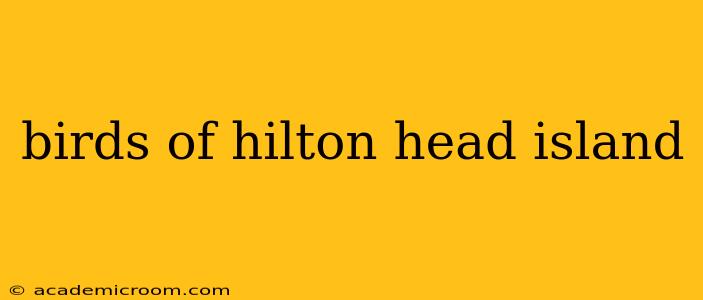Hilton Head Island, South Carolina, is a haven for birdwatchers, boasting a diverse array of avian species throughout the year. Its unique blend of maritime forests, salt marshes, and beaches provides ideal habitats for a wide range of birds, from migratory shorebirds to resident woodland species. This guide delves into the fascinating world of Hilton Head's birdlife, offering insights for both seasoned ornithologists and casual observers.
What birds can you see on Hilton Head Island?
Hilton Head Island's diverse ecosystems support a remarkable variety of bird species. During different seasons, you'll encounter different species, making each visit a unique birding experience. Common residents include the Carolina Wren, Northern Cardinal, Brown Thrasher, and various woodpeckers. Migratory birds, like warblers, vireos, and tanagers, grace the island during spring and fall, transforming the landscape into a vibrant symphony of colors and songs. Coastal areas are home to shorebirds such as sandpipers, plovers, and gulls. Raptors like Osprey and Bald Eagles also frequent the island, offering breathtaking aerial displays. Specific sightings depend heavily on the time of year and location on the island.
What is the best time of year to birdwatch on Hilton Head Island?
The best time to birdwatch on Hilton Head Island is during the spring and fall migrations (March-May and September-November). During these periods, numerous migratory birds pass through, significantly increasing the diversity of species observable. However, resident birds offer year-round viewing opportunities, making any time a good time to visit for birdwatching. Winter can bring interesting seabirds and waterfowl.
Where are the best places to birdwatch on Hilton Head Island?
Several locations on Hilton Head Island are renowned for their excellent birdwatching opportunities:
- Coastal areas: Beaches, like Coligny Beach and Folly Field Beach, attract various shorebirds.
- Hilton Head Island's maritime forests: These forests are home to a wide array of woodland birds. Specific trails within these forests offer varying levels of difficulty and access.
- Salt marshes: Areas like the Pineland Nature Preserve and the Broad Creek Marina offer excellent views of marsh birds.
- Parks and preserves: Check out the local parks and preserves; they often feature designated birdwatching trails and observation points.
What kind of birds are in the Hilton Head marshes?
Hilton Head's salt marshes are vibrant ecosystems supporting a rich array of birdlife. Expect to see wading birds such as herons (Great Blue Heron, Great Egret, Snowy Egret), egrets, ibis, and various species of rails. These marshes also provide vital habitats for migratory shorebirds. Brown Pelicans and various gulls are also commonly sighted in marsh areas.
What are some tips for birdwatching on Hilton Head Island?
- Bring binoculars: Essential for close-up views of birds.
- Use a field guide: Helps in identifying the various species.
- Dress appropriately: Wear comfortable clothing and shoes suitable for walking on various terrains.
- Be patient and quiet: Birds are easily disturbed by loud noises and sudden movements.
- Respect wildlife: Maintain a safe distance from birds and their nests.
- Check the tide schedule: The tide significantly affects the visibility of shorebirds in coastal areas.
- Bring insect repellent: Mosquitoes can be prevalent in certain areas, especially during warmer months.
- Consider joining a guided birdwatching tour: Local experts can provide valuable insights and enhance your experience.
Conclusion
Hilton Head Island offers a truly unique and rewarding birding experience. With its diverse habitats and abundant birdlife, the island is a paradise for bird enthusiasts of all levels. By following these tips and exploring the various locations mentioned above, you're sure to have a memorable and enriching birdwatching adventure on this beautiful South Carolina island. Remember to always respect the environment and wildlife. Happy birding!
